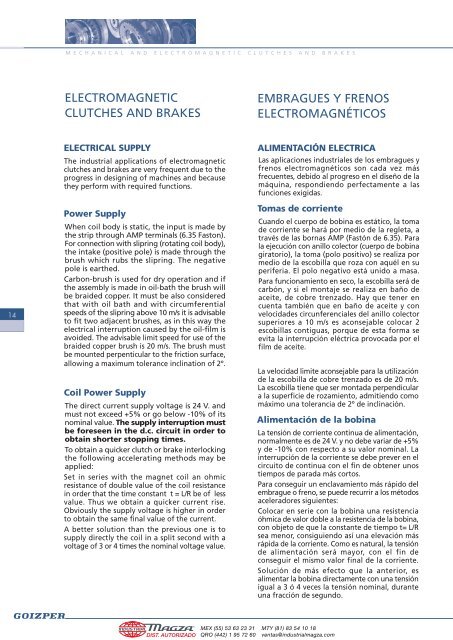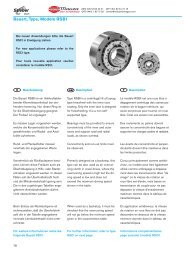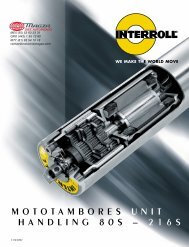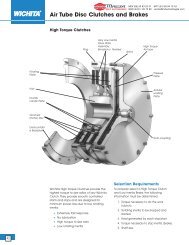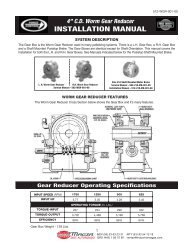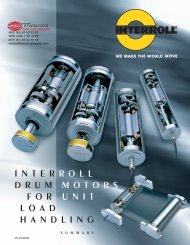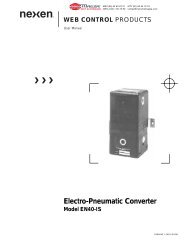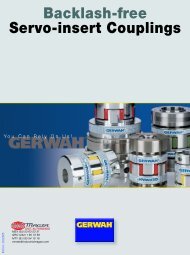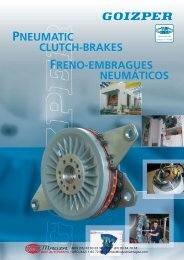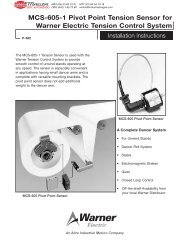Embragues y Frenos Mecanicos y Electromagneticos - Industrial ...
Embragues y Frenos Mecanicos y Electromagneticos - Industrial ...
Embragues y Frenos Mecanicos y Electromagneticos - Industrial ...
Create successful ePaper yourself
Turn your PDF publications into a flip-book with our unique Google optimized e-Paper software.
M E C H A N I C A L A N D E L E C T R O M A G N E T I C C L U T C H E S A N D B R A K E S<br />
ELECTROMAGNETIC<br />
CLUTCHES AND BRAKES<br />
EMBRAGUES Y FRENOS<br />
ELECTROMAGNÉTICOS<br />
14<br />
ELECTRICAL SUPPLY<br />
The industrial applications of electromagnetic<br />
clutches and brakes are very frequent due to the<br />
progress in designing of machines and because<br />
they perform with required functions.<br />
Power Supply<br />
When coil body is static, the input is made by<br />
the strip through AMP terminals (6.35 Faston).<br />
For connection with slipring (rotating coil body),<br />
the intake (positive pole) is made through the<br />
brush which rubs the slipring. The negative<br />
pole is earthed.<br />
Carbon-brush is used for dry operation and if<br />
the assembly is made in oil-bath the brush will<br />
be braided copper. It must be also considered<br />
that with oil bath and with circumferential<br />
speeds of the slipring above 10 m/s it is advisable<br />
to fit two adjacent brushes, as in this way the<br />
electrical interruption caused by the oil-film is<br />
avoided. The advisable limit speed for use of the<br />
braided copper brush is 20 m/s. The brush must<br />
be mounted perpenticular to the friction surface,<br />
allowing a maximum tolerance inclination of 2º.<br />
Coil Power Supply<br />
The direct current supply voltage is 24 V. and<br />
must not exceed +5% or go below -10% of its<br />
nominal value. The supply interruption must<br />
be foreseen in the d.c. circuit in order to<br />
obtain shorter stopping times.<br />
To obtain a quicker clutch or brake interlocking<br />
the following accelerating methods may be<br />
applied:<br />
Set in series with the magnet coil an ohmic<br />
resistance of double value of the coil resistance<br />
in order that the time constant t = L/R be of less<br />
value. Thus we obtain a quicker current rise.<br />
Obviously the supply voltage is higher in order<br />
to obtain the same final value of the current.<br />
A better solution than the previous one is to<br />
supply directly the coil in a split second with a<br />
voltage of 3 or 4 times the nominal voltage value.<br />
ALIMENTACIÓN ELECTRICA<br />
Las aplicaciones industriales de los embragues y<br />
frenos electromagnéticos son cada vez más<br />
frecuentes, debido al progreso en el diseño de la<br />
máquina, respondiendo perfectamente a las<br />
funciones exigidas.<br />
Tomas de corriente<br />
Cuando el cuerpo de bobina es estático, la toma<br />
de corriente se hará por medio de la regleta, a<br />
través de las bornas AMP (Fastón de 6.35). Para<br />
la ejecución con anillo colector (cuerpo de bobina<br />
giratorio), la toma (polo positivo) se realiza por<br />
medio de la escobilla que roza con aquél en su<br />
periferia. El polo negativo está unido a masa.<br />
Para funcionamiento en seco, la escobilla será de<br />
carbón, y si el montaje se realiza en baño de<br />
aceite, de cobre trenzado. Hay que tener en<br />
cuenta también que en baño de aceite y con<br />
velocidades circunferenciales del anillo colector<br />
superiores a 10 m/s es aconsejable colocar 2<br />
escobillas contiguas, porque de esta forma se<br />
evita la interrupción eléctrica provocada por el<br />
film de aceite.<br />
La velocidad limite aconsejable para la utilización<br />
de la escobilla de cobre trenzado es de 20 m/s.<br />
La escobilla tiene que ser montada perpendicular<br />
a la superficie de rozamiento, admitiendo como<br />
máximo una tolerancia de 2º de inclinación.<br />
Alimentación de la bobina<br />
La tensión de corriente continua de alimentación,<br />
normalmente es de 24 V. y no debe variar de +5%<br />
y de -10% con respecto a su valor nominal. La<br />
interrupción de la corriente se debe prever en el<br />
circuito de continua con el fin de obtener unos<br />
tiempos de parada más cortos.<br />
Para conseguir un enclavamiento más rápido del<br />
embrague o freno, se puede recurrir a los métodos<br />
aceleradores siguientes:<br />
Colocar en serie con la bobina una resistencia<br />
óhmica de valor doble a la resistencia de la bobina,<br />
con objeto de que la constante de tiempo t= L/R<br />
sea menor, consiguiendo así una elevación más<br />
rápida de la corriente. Como es natural, la tensión<br />
de alimentación será mayor, con el fin de<br />
conseguir el mismo valor final de la corriente.<br />
Solución de más efecto que la anterior, es<br />
alimentar la bobina directamente con una tensión<br />
igual a 3 ó 4 veces la tensión nominal, durante<br />
una fracción de segundo.<br />
DIST. AUTORIZADO<br />
®<br />
MEX (55) 53 63 23 31<br />
QRO (442) 1 95 72 60<br />
MTY (81) 83 54 10 18<br />
ventas@industrialmagza.com


